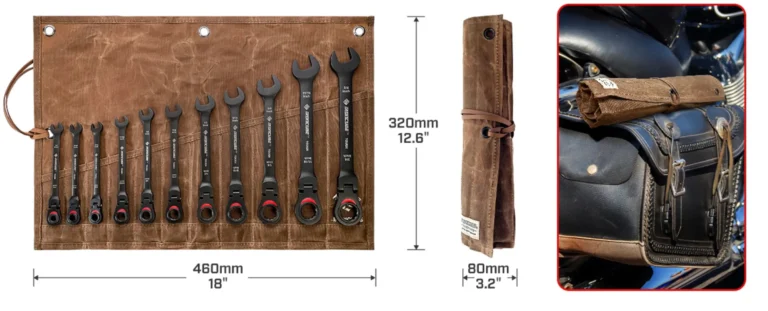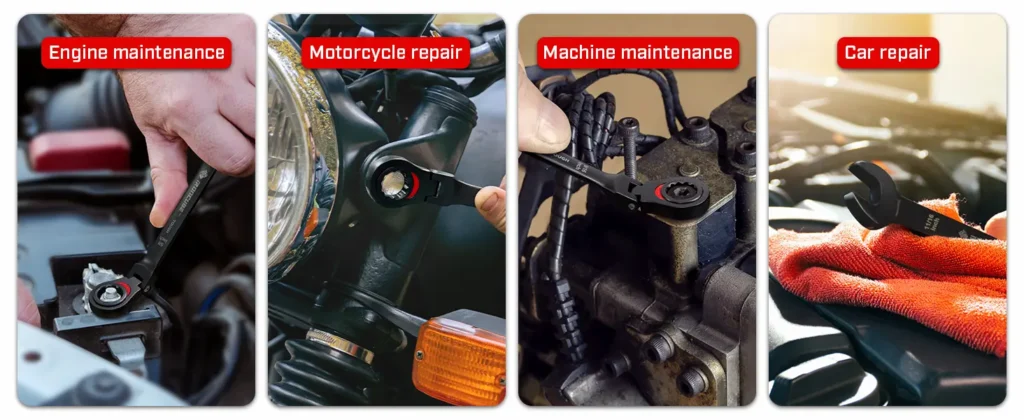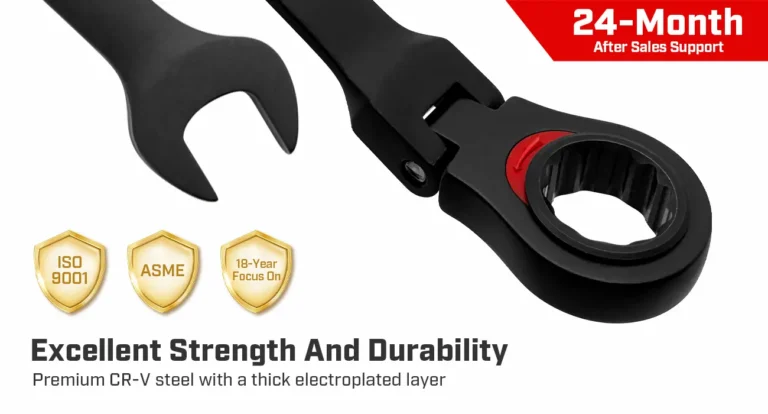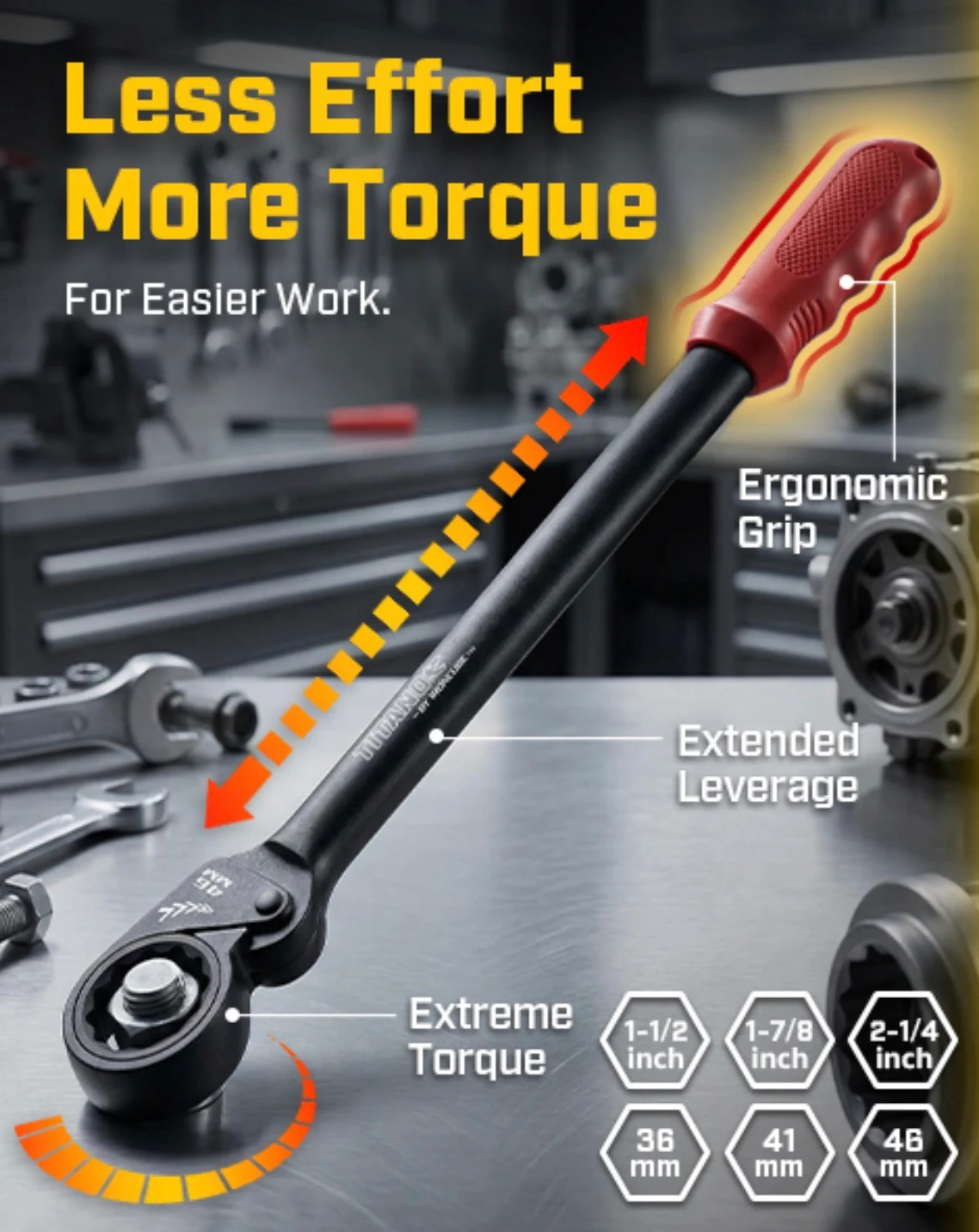Have you ever tried to loosen bolts buried deep in the engine compartment, hidden behind pipes, or tucked away under cabinets? Ordinary wrenches force your wrist into awkward positions, or worse, require you to remove half the surrounding components just to reach the fastener. That’s where the flexible head ratchet comes in. For American DIY enthusiasts and professional mechanics, it’s the difference between working quickly and battling all day.

Definition: What Is a Flex Head Ratchet?
A flexible head ratchet (also known as a flex head ratchet wrench) is a manual tool that combines a standard ratchet mechanism with a pivot joint between the ratchet head and the handle. Unlike fixed-head ratchets, where the head is rigidly connected to the handle, the flexible-head design uses a hinge or ball-and-socket joint (typically a hardened steel pin passing through matching ears) that allows the head to tilt forward or backward, usually up to 180°.
Find The Best Ratcheting Wrench Sets For You From Ironcube
The “flexible” part comes from this hinge. Depending on the model, the joint may:
- Braking/Semi-locking – Some flex head ratchets use spring-loaded ball brakes to fix the head at a specific angle while still allowing for quick adjustments. Some flexible head ratchets do not have fixers, which greatly reduces costs while still meeting user needs.
- Flexibility: The ratchet end can be rotated 180°, and some flex head ratchets can even reach 270°.
- Inside the head, the ratchet mechanism operates similarly to a standard ratchet: the gear ring engages with spring-loaded pawls, allowing the driver to rotate in one direction while freely rotating in the opposite direction. The pivot joint simply changes the head’s orientation relative to the handle, enabling you to align the ratchet with fasteners from nearly any approach angle without affecting ratchet operation.
- This mechanical combination—hinge head + ratchet gear—enables the flexible head ratchet to reach bolts and nuts from angles that are physically impossible for a fixed head ratchet, especially in narrow or obstructed spaces.

How does flexible head ratchet Works:
Adjustable head pivot – The head is mounted on a hinge, allowing it to swing forward and backward. In a free-floating design, it can move freely; in a locking type, it is set to a fixed angle, such as forward or backward.
Ratchet mechanism – Like any ratchet, it allows fasteners to turn in one direction while allowing free movement in the other direction without removing the tool. Fine-toothed gears (72 or more) mean smaller arc swings – crucial in tight spaces.
Off-angle loading – Many high-quality flexible head ratchets can grip the flat surface of the fastener rather than the corner, reducing the chance of rounding.
Torque transmission – Even at certain angles, the hinge and gear mechanism effectively transmit torque, though maximum torque is typically achieved when the head is aligned with the handle.
How to Use a Ratchet Wrench: Complete Step-by-Step Guide
flexible head ratchet‘s Key Benefits

1. Access in Tight or Awkward Spaces
Imagine you are repairing a car engine. Due to the various pipes inside the engine, the fixed-head ratchet forces you to approach the bolt in a straight line—which is usually impossible without removing the surrounding components.
The flex head ratchet completely changes this. Its rotating head can swing 180° (some models even reach 270°), keeping the handle away from obstacles while aligning the head directly with the fastener. Whether you’re reaching around an exhaust manifold or behind a wall-mounted fixture, you can approach from the side, above, or even diagonally. This means fewer parts to remove, less time spent setting up, and significantly reduced frustration.
- Pro tip: When working on an engine, set the head just off-centre so your knuckles can clear nearby components without sacrificing torque.
2. Faster Workflow
You set the angle once, and then the ratchet mechanism (typically 72 teeth or finer) takes over, allowing you to turn the fastener in 5° arc movements.
In scenarios such as assembling metal frames in confined spaces like kitchens, the ability to instantly adjust the head angle means you can maintain momentum. Otherwise, you would need to dismantle a significant amount of surrounding fixtures to complete the bolt tightening.
- Pro tip: For repetitive bolts in similar positions, lock the head angle so you can perform the motion by muscle memory without readjusting.
3. Protects fasteners
nyone who has ever struggled with bolts in awkward positions knows the wrist strain that comes with it. Traditional ratchets typically force you into extreme wrist angles, putting pressure on tendons and reducing leverage, thereby increasing the likelihood of tendon strain.
The flexible-head ratchet allows you to adjust the head so your hand and forearm remain in an ergonomic neutral position, making it the ideal choice for power and comfort. Over the course of a long day, this ergonomic advantage can reduce soreness, minimise breaks, and improve focus. For DIY users, it’s more comfortable; for professionals who may use the tool all day, it’s a true injury prevention measure.
- Pro tip: When working overhead, adjust the head angle to keep your wrist straight—this maximises power while minimising strain.
4. Multi-Angle Versatility
Not all jobs require the same head behaviour. A locking flexible head ratchet allows you to set a precise angle and hold it in place, which is critical for high-torque applications where stability is important, such as breaking loose rusted suspension bolts.
On the other hand, the free-pivot design moves smoothly and adapts instantly to changing fastener positions in light-duty work, such as panel assembly or equipment maintenance. This range of options means a single tool can handle precision work, heavy loads, and quick adjustments without switching between different ratchets.
- Pro tip: Keep both locking and free-pivot flexible head ratchets in your kit—switching between them based on torque and stability requirements will save time and protect your tools.
5. One Tool for Multiple Scenarios
A well-designed flex head ratchet can typically replace two or even three other tools in a kit. In light to medium torque applications, it can handle standard ratchet work, and its angled position can sometimes replace a breaker bar in tight spaces.
For mobile mechanics or technicians working on-site, this integration is a big deal—less weight in the toolbox, fewer tools to keep track of, and faster transitions between tasks. For home users, this means a single purchase covers a wide range of repair and maintenance tasks.
- Pro tip: Pair your flexible-head ratchet with a set of deep and shallow sockets to maximise the range of tasks a single ratchet can handle.
Real-World Use Cases
Car maintenance – Narrow engine compartment, limited suspension bolt clearance.
Motorcycle maintenance – Access to frame and engine fasteners without dismantling nearby components.
Home renovation – Assemble furniture and tighten fasteners behind obstacles.
Industrial equipment – Make adjustments in machinery where access paths are blocked by structural components.
Kitchen repair – In situations such as securing kitchen cabinets, a flexible head ratchet can be used to tighten fasteners on the back of the cabinet.
Buying flex head ratchet Tips
Check the number of teeth – Higher numbers (72, 84, 144) provide smoother operation in confined spaces.
Consider locking vs. free pivot – Choose locking for high torque stability, choose free pivot for speed.
Material matters – Chrome-vanadium steel with a corrosion-resistant coating ensures the longevity of the flexible head ratchet.
Handle comfort – The slim yet contoured handle of the flexible head ratchet aids control in awkward positions.
Product Features: This set is made of high-strength chromium-vanadium (Cr-V) steel and features a 72-tooth gear, enabling quick and efficient operation. The flexible head can be rotated, significantly improving the operational flexibility of a standard fixed wrench in confined spaces.
Portable Storage: Includes a durable waxed canvas storage bag that is water-resistant and long-lasting, keeping tools organised and tidy.
User Feedback Highlights:
From Amazon user reviews, we can see:
“They are well made, the gearing and selector are smooth. The bag is good also.”
“They work well and offer good value for the set given the quality.”
“I love these wrenches. They are slim and can reach into tight spaces.”
Cost-effectiveness: Most users believe that the product strikes a good balance between practicality and price, making it particularly suitable for users who want to upgrade the quality of their tools but have a limited budget.
Design and aesthetics: The black stain-resistant coating and precise dimensions make the tools not only durable but also professional-looking.
Durability Feedback: While overall reviews are positive, a few users have mentioned durability issues, such as loosening or breaking at connection points under high-intensity use. It is recommended to exercise caution in heavy-duty applications.

Recommended for
| User Types | Recommended Reasons |
| DIY enthusiasts/home repairers | The flexible head design makes it easy to work in tight spaces such as behind furniture or under countertops, offering excellent value for money. |
| Entry-level professional technicians | Newly trained technicians are price-sensitive, and the set covers commonly used sizes, making it ideal as a basic tool for work. |
| Car owners on a budget | It can handle routine maintenance in compact vehicle cabins, offering strong versatility and practical value. |
Usage and Maintenance Recommendations
In high-torque or heavy-load environments, regularly inspect the flexible head connection for looseness and tighten or maintain it in a timely manner to extend its service life.
Keep the gears clean and lubricated to reduce jamming and wear, especially in environments with high levels of dust and oil stains.
When storing, use the included wax cloth bag to prevent moisture corrosion and metal surface oxidation.


